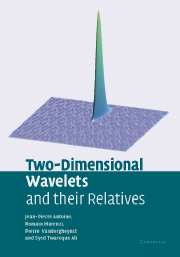Book contents
- Frontmatter
- Contents
- Prologue
- 1 Warm-up: the 1-D continuous wavelet transform
- 2 The 2-D continuous wavelet transform
- 3 Some 2-D wavelets and their performance
- 4 Applications of the 2-D CWT. I: image processing
- 5 Applications of the 2-D CWT. II: physical applications
- 6 Matrix geometry of wavelet analysis. I
- 7 Matrix geometry of wavelet analysis. II
- 8 Minimal uncertainty and Wigner transforms
- 9 Higher-dimensional wavelets
- 10 Spatio-temporal wavelets and motion estimation
- 11 Beyond wavelets
- Epilogue
- Appendix: Some elements of group theory
- References
- Index
1 - Warm-up: the 1-D continuous wavelet transform
Published online by Cambridge University Press: 19 August 2009
- Frontmatter
- Contents
- Prologue
- 1 Warm-up: the 1-D continuous wavelet transform
- 2 The 2-D continuous wavelet transform
- 3 Some 2-D wavelets and their performance
- 4 Applications of the 2-D CWT. I: image processing
- 5 Applications of the 2-D CWT. II: physical applications
- 6 Matrix geometry of wavelet analysis. I
- 7 Matrix geometry of wavelet analysis. II
- 8 Minimal uncertainty and Wigner transforms
- 9 Higher-dimensional wavelets
- 10 Spatio-temporal wavelets and motion estimation
- 11 Beyond wavelets
- Epilogue
- Appendix: Some elements of group theory
- References
- Index
Summary
What is wavelet analysis?
Wavelet analysis is a particular time- or space-scale representation of signals that has found a wide range of applications in physics, signal processing and applied mathematics in the last few years. In order to get a feeling for it and to understand its success, we consider first the case of one-dimensional signals. Actually the discussion in this introductory chapter is mostly qualitative. All the mathematically relevant properties will be described precisely and proved systematically in the next chapter for the two-dimensional case, which is the proper subject of this book.
It is a fact that most real life signals are nonstationary (that is, their statistical properties change with time) and they usually cover a wide range of frequencies. Many signals contain transient components, whose appearance and disappearance are physically very significant. Also, characteristic frequencies may drift in time (e.g., in geophysical time series – one calls them pseudo-frequencies). In addition, there is often a direct correlation between the characteristic frequency of a given segment of the signal and the time duration of that segment. Low frequency pieces tend to last for a long interval, whereas high frequencies occur in general for a short moment only. Human speech signals are typical in this respect: vowels have a relatively low mean frequency and last quite a long time, whereas consonants contain a wide spectrum, up to very high frequencies, especially in the attack, but they are very short.
Information
- Type
- Chapter
- Information
- Two-Dimensional Wavelets and their Relatives , pp. 1 - 31Publisher: Cambridge University PressPrint publication year: 2004
